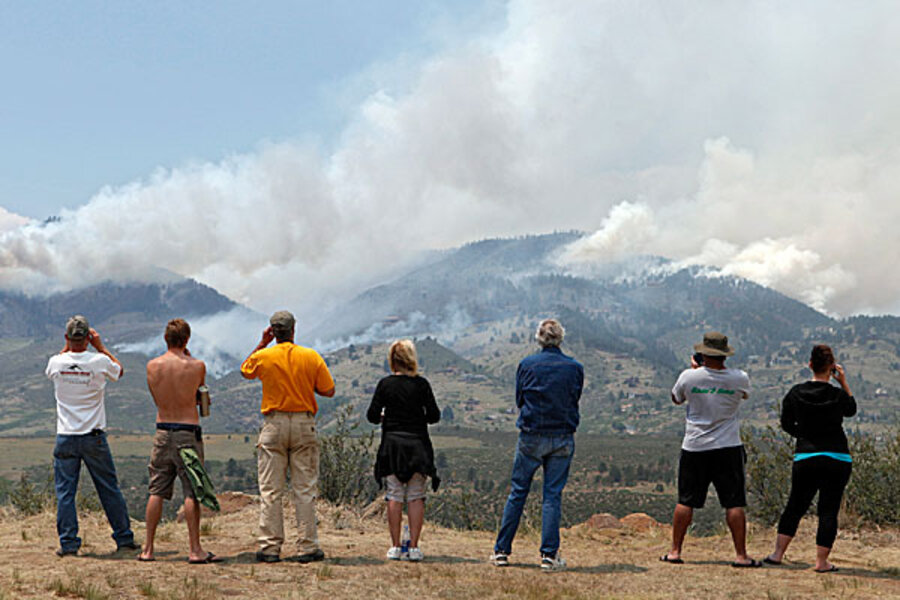Colorado wildfire takes its first fatality
| Bellvue, Colorado
One person was dead as massive wildfires in drought-parched Colorado and New Mexico burned out of control, while Western lawmakers pleaded for updates to an aging US aerial firefighting fleet needed to combat a fire season that lasts year-round.
About 600 firefighters were expected to be battling the fire by Tuesday, said incident commander Bill Hahnenberg. "We are a very high priority nationally. We can get all the resources we want and need," he said.
The Colorado fire has destroyed at least 118 structures, and hundreds of people have been forced to abandon their homes.
IN PICTURES: Colorado wildfires
The U.S. Forest Service said late Monday it would add more aircraft to its aerial firefighting fleet, contracting one air tanker from the state of Alaska and four from Canada. Two more air tankers were being activated in California.
The announcement came after Colorado's U.S. House congressional delegation demanded that the U.S. Forest Service deploy more resources to the fire, which was totally uncontained.
The Larimer County sheriff's office confirmed Monday that one person had died.
The family of Linda Steadman, 62, had reported her missing after the fire started Saturday, sheriff's officials said. Investigators found remains in her burned home Monday that haven't been positively identified yet, but her family issued a statement saying Steadman died in the cabin she loved.
In a letter to the Forest Service, Colorado's congressmen said the need for firefighting aircraft was "dire." Colorado U.S. Sen. Mark Udall urged President Barack Obama to sign legislation that would allow the Forest Service to contract at least seven large air tankers to add to its fleet of 13 — which includes the two on loan from Canada.
One of the region's most potent aerial firefighting forces — two Wyoming Air National Guard C-130s fitted to drop slurry — sat on a runway in Cheyenne, 50 miles (80 kilometers) north of the Colorado fire. The reason: The U.S. Forest Service, by law, cannot call for military resources until it deems that its fleet is fully busy. It also takes 36 hours to mobilize the crews and planes, officials said.
"They just haven't thrown the switch yet because they feel like there are adequate resources available," said Mike Ferris, a spokesman for the National Interagency Fire Center in Boise, Idaho.
Colorado was using five of 13 air tankers available nationally, said Forest Service spokesman Steve Segin.
Meanwhile, helicopters were used to suck water from a reservoir and drop it on nearby homes dangerously close to the flames.
Evacuees expressed gratitude for the help.
"They're doing the best they can," said Barb Hermsen as she watched a helicopter make daring raids through smoke and flame. "We know how much they have to go through, and where they're going — man, it's crazy."
In New Mexico, firefighters used a break in the hot and windy weather and got new air and ground support to battle a fast-moving wildfire that charred tens of thousands of acres and forced hundreds of residents to leave their homes in the southern part of the state.
An estimated 35 structures have been damaged or destroyed by the blaze, and fire managers expect that number to grow once damage assessments are done.
Elsewhere in New Mexico, firefighters made slow progress against the largest wildfire in state history. The blaze has charred 435 square miles (1,126 square kilometers) of forest since it was sparked by lightning in mid-May, and was 37 percent contained Monday.
U.S. Forest Service Chief Tom Tidwell has long insisted the federal government has enough resources to respond to a year-round wildfire season driven by drought, heat, decades of fighting forest fires rather than letting them run their natural course, and bark beetle pine tree kill.
"We have enough resources at this time to be able to deal with the fires we currently are dealing with and what we expect to have to deal with the rest of this fire season," Tidwell told The Associated Press last week. He emphasized that the forest service has the authority to transfer funds from other accounts to meet firefighting costs in any given year.
IN PICTURES: Colorado wildfires
___
Associated Press writers Susan Montoya Bryan in Albuquerque, New Mexico; Felicia Fonseca in Flagstaff, Arizona; and Mead Gruver in Cheyenne, Wyoming, contributed to this report.
Copyright 2012 The Associated Press.








